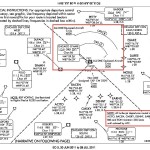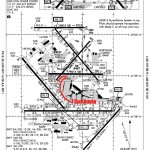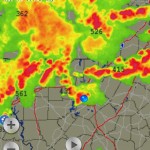Tag: story
Part 2 – New Kid On The Ramp: My First Day Flying From Chicago
Read Part 1 of New Kid On The Ramp: My First Day Flying From Chicago
To pick up where I last left off… We had been cleared for takeoff from Chicago via the O’Hare 5 departure which states you’ll climb to 5,000 feet after takeoff. This procedure requires specific altitude crossing restrictions during the climb out so that you are at or above 3,000 feet by five miles from the airport and at or above 4,000 feet by eight miles from the airport, all while still climbing your way to 5,000 feet. But, in order to do this in the Embraer 145 we have to first consult our climb gradient charts.

Consulting the Charts
The climb gradient charts tell us the maximum allowable aircraft weight for each specific runway and a range of outside air temperatures that allows us to ensure we are able to meet all the climbing requirements of the O’Hare 5 departure. Based on an outside air temperature of 32 degrees Celsius departing runway 4 Left, the aircraft would have to weigh less than 48,725 pounds if we were expected to make all our altitude targets; it’s a good thing I didn’t eat that box of Krispy Kremes for breakfast. Although, we wouldn’t be able to accomplish this departure under our normal takeoff climb profile. This is where the fun begins!
During takeoff, and once the aircraft is airborne, we accelerate in airspeed to 250 knots below 10,000 feet , about 288 mph. With today’s outside air temperature and maximum allowable takeoff weight required for the O’Hare 5 departure we’d have to fly an alternate takeoff profile. This profile dictates that we use our maximum thrust setting, flaps set to nine degrees, and climb at a constant speed of roughly 150 knots instead of accelerating to 250 knots. We also won’t retract the flaps until we are 2,000 feet above the ground.
Normally the flaps are retracted at 500 feet above the ground, so by delaying the aircraft configuration changes and holding a constant climb speed, we have a significantly increased climb angle that allows us to hit the 3,000 feet by five miles and 4,000 feet by eight miles altitude targets. Basically, this alternate takeoff profile allows us to climb like a homesick angel on crack flying higher and quicker, using less distance across the ground.
It’s Time for Takeoff
We’re 50 minutes late departing Chicago due to our previously mentioned maintenance squawks and these passengers are jonesing to get to Raleigh-Durham for their 4th of July festivities. Now that all the performance numbers look good we push off the gate, start the engines, call for taxi, and make our way out to runway 4 Left.

Our taxi instructions are to follow the ramp as it curves on Taxiway Alpha, left turn on Taxiway Hotel, double back on Taxiway Bravo, to hold short of runway 4 Left on Taxiway Echo. We’ll have the full runway length of 7,500 feet available for takeoff from this position. Once the preceding aircraft in front of us have all been cleared for take off, I receive the following instructions from O’Hare tower, “You’re cleared for takeoff, no delay, landing traffic is three miles out, turn right to heading 120.”
We round the corner of the runway, line the plane up on centerline, and advance the thrust levers full forward. As we start rolling down the runway I see the previously departed aircraft just lifting off the other end of our runway. There’s no doubt that Chicago runs a tight operation and moves a large volume of aircraft departing us so close like this. The other aircraft is given a different heading than ours as not to be a traffic conflict, but it’s still a tight fit. I love it!
As we reach our liftoff speed and the Captain begins to pull back on the control yoke to raise the aircraft nose off the ground, I notice there’s only 2,000 feet of runway remaining in front of us and the fence line is approaching fast. We used over 5,500 feet to get airborne today and while it’s not always normal to use so much runway, it’s occasionally common to see the other end of a runway, fence, or trees rapidly approaching during lift off. Today was no exception there; it’s hot outside and the aircraft is heavy. But have no fear, our performance data accounts for this so there is no safety issue.
Keep It Slow, Sir
Becoming airborne we fly according to profile. Accelerate to 150 knots, no aircraft configuration changes until 2,000 feet above the ground, and execute a right hand turn to our assigned heading of 120. Usually, we can accelerate to the aircrafts maximum airspeed above 10,000 feet, roughly 310 knots or 357 mph, but because of the waypoints on our flight plan we’re restricted to an airspeed of 250 knots until Chicago air traffic control approves a faster speed. We’re eventually cleared to increase our airspeed and climb to our cruising altitude of 33,000 feet on our way to Raleigh-Durham, NC.
During the flight the Captain and I discuss the weather ahead. Knowing that we have some thunderstorms to navigate around we elect to climb up to our highest altitude and aircraft service ceiling of 37,000 feet, also known as Flight Level Three-Seven-Zero or FL370, with hopes to get above some of the storms ahead. Note: All altitudes above 18,000 feet are referred to as Flight Levels and abbreviated by FL. Because of the forecast thunderstorms at our arrival airport we are required to have an alternate landing airport on file. Today that would be Greensboro, NC which was forecast to have better weather than Raleigh-Durham. Hopefully, we don’t need to go there because I’m hungry and ready to get to the overnight.
Blast You Naughty Weather
Everything is moving along smoothly inflight until the thunderstorms start closing in on Raleigh-Durham faster than expected. They’re moving towards the airport at 35 knots and appear to be beating us there. At this point there’s no turning around to our alternate landing airport of Greensboro because they too are getting pummeled by unforecast thunderstorms. If we can’t get into Raleigh we’ll have to go somewhere else like Charlotte to land, refuel, and wait the storms out. It would be pointless, as well as a waste of fuel, to enter any holding pattern. We would just end up running out of gas trying to wait for the storms to pass. The day just keeps getting more complicated.
Looking at our airborne radar we find a hole between two storms and decided make our way through. Thankfully it turned out to be an ok decision as the air was mostly smooth during this transition between thunderstorms. All was looking well until we started receiving radar vectors to our final approach course. The thunderstorm was now just a few miles away from the Raleigh-Durham airport, producing 40 knot downdrafts over the city and spewing lighting left and right as we line up for the approach. The Captain says he wants to make the turn to final and have one last look on the radar and visually out front. I tell him, “I’ll give you that much. But, if I don’t like what I see, we’re outta here.” He agrees.

I ask the air traffic controller about the downdrafts and he states that the winds are 13 knots at Raleigh so the storm isn’t affecting landing traffic just yet. As we line up on our final approach we fly through some short bursts of moderate rainfall. The Captain calls for the windshield wipers because flying through rain at 160+ mph is blinding. Just then, lighting strikes two miles off our right wing. This storm is getting close! I double check with air traffic control about the downdrafts and airport winds. No downdrafts reported, winds at Raleigh-Durham are now 18 knots and holding steady. Even though there’s a few patchy areas of rainfall we can actually see the airport and the runway. The joint decision is made to continue our approach.
Mr Toads Wild Flight
A quick briefing is exchanged between us that in the even of any windshear alerts on our aircraft instruments, we’ll execute a go-around with no aircraft configuration changes until we’re clear of the conflict. Passing in and out of the rain, I can see the storm approaching the western half of the airport as we’re about one mile from the runway. We’re landing on the east side of the airport so we’re still able to maintain visual contact with the runway. Air traffic control announces windshear in the form of a 20 knot increase in wind speed just three miles behind us, north of the airport. The windshear isn’t affecting us but it’s clear this thunderstorm is just drooling at the mouth to wreak havoc upon the airport.
The last mile of the flight is somewhat uneventful considering this thunderstorm barreling towards the airport. With just a touch of rain and some minor changes in wind speed and direction during short approach, we land safely on runway 23 Left. Clearing the runway we exhale a sigh of relief as we taxi around the south end of the airport to the ramp where we’ll be parking.
Not So Fast, Guys
Due to the impending thunderstorm looming overhead and the lighting it’s been throwing around, the ramp is closed for safety reasons. The airport won’t allow any ramp personnel outside to marshall us into the gate for unloading. We’re told to park in a remote section of the ramp to wait out the storm. There can’t be any lightning strikes within five miles of the airport for a certain amount of time before the ramp is allowed to open again. I think it’s some kind of OSHA safety rule but it makes sense. It takes nearly 50 minutes before we’re actually able to park the plane at the gate and off load passengers and bags.
Time to head to the hotel and grab a beer!
Please submit any comments below. I’d love to hear from you.
Clear Skies & Calm Winds,
Len @ The Pilot Report
PS – Make sure to click that donate button on the top right hand side of this page and contribute a few bucks to the “buy-Len-a-beer fund” because, after a day like today, a nice tall frosty beverage would really hit the spot!
